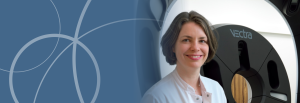Skin cancer diagnostics

What is melanoma?
When are skin cancer diagnostics needed?
What to expect from the diagnostics?
Melanoma: seeking clarity as quickly as possible
You are likely visiting this website because you have been referred by your general practitioner or specialist for further diagnostics. Changing spots on the skin, a mole with an unusual shape, a rapidly growing, bleeding, itchy, or restless mole; these may be signs of melanoma. After referral, you can come to the NKI Center for Early Diagnostics for further diagnostics.
Skin cancer is the most common form of cancer worldwide among people with a lighter skin type. It is a collective term for various types of skin cancers. Melanoma is an aggressive form of skin cancer. Melanoma can develop on healthy skin or from an existing mole. Melanoma can appear anywhere on the skin, including the scalp or the foot soles.
A skin pigmentation or mole with one or more of the following characteristics could be melanoma:
- Irregular edges: no smooth, clean border
- Odd shape, not symmetrical or round
- A mix of different colors (dark and light)
- Larger than 6 millimeters
- The pigmentation appeared suddenly, or an existing mole starts to change, itch, or grow
It can be. If melanoma occurs in your immediate family, you may want to have your moles checked thoroughly every year. We may recommend remaining under our Center’s care after your skin examination.
Definitely not. There are many types of skin cancer. Only about 12% of all skin cancers are melanomas.
No, skin examinations are not painful. At the NKI Center for Early Diagnostics, we use the latest equipment, the Vectra WB360. You will have to stand in front of the camera, and the device takes 92 3D images of your entire body. You will receive more clarity quickly based on these images and additional skin examinations by the dermatologist. Is melanoma present? We may want to remove a mole (under anesthesia) for further investigation.
Certainly, you can go elsewhere for skin examinations. However, we have the Vectra WB360: this allows us to take high-resolution 3D photos of the entire body within seconds. Globally, we are one of the few research centers using this state-of-the-art equipment. The technology increases the accuracy of examinations and follow-up assessments.

